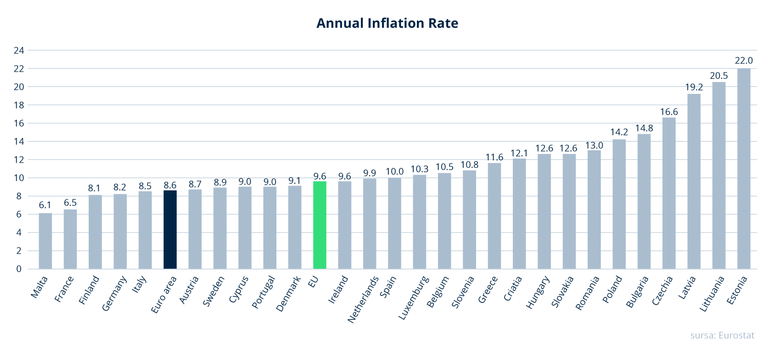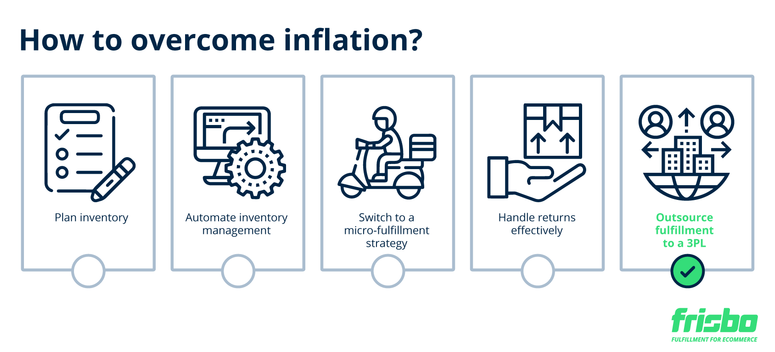
How to prepare your online store to overcome inflation
Running a successful online store is becoming more challenging in today's business environment. But with the right strategies, your business can thrive even during inflationary times. Our partners, Frisbo's tips help you and your online store to keep inflation at bay and drive profits in times of economic uncertainty.
While the entire world is still trying to recover from the pandemic, 2022 political conflicts have slowed down the global economic improvement. Disrupting exports of crude oil, natural gas, grains, fertilizer, and metals, along with pushing up energy, food, and commodity prices, are making matters worse in terms of inflation.
In Europe, according to the latest Eurostat report, the annual inflation rate was confirmed at a record high of 8.6% in June of 2022, compared to 8.1% in May and 1.9% a year earlier.
Worldwide, projections show increases of 6.7% in 2022 - twice the average of 2.9% recorded during 2010–2020. And there are few signs of a comeback soon.
If you're an e-commerce business owner, you know that running a successful online store is becoming more challenging in today's business environment. Supply chain disruptions, logistics bottlenecks, and overall price increases are playing their part in deterring the e-commerce market development or stagnation. But with the right strategies and knowledge, your business can thrive even during inflationary times.
Here are some tips to help you and your online store to keep inflation at bay and drive profits in times of economic uncertainty.
But first, let's see where we're currently standing.
What is inflation and what is causing its increase?
Simply put, inflation is a continuous increase in the general price of goods and services in an economy over a particular time. The money earned today is simply way less valuable than it once was.
Inflation is often measured by changes in the consumer price index (a measure of the average change in prices paid by urban consumers for a market basket of goods and services), although it can be measured by changes in other indexes such as the GDP price deflator (indicating how much a rise in GDP depends on changes in the level of prices), or core inflation (a commonly cited indicator of the general direction of average consumer prices).
Covid-19 lockdowns, the Russian-Ukrainian crisis, and the ever more supply chain disruptions have been decisive for today's inflation rate, eroding purchasing power and making goods and services increasingly more expensive. Below, you can see how the prices for the most used products and services have evolved over the last 12 months.
How does inflation impact online retail?
Are you wondering how inflation is affecting your e-commerce business? If we look at Adobe's Digital Economy Index, consumers spent $1.7 trillion online over the course of the COVID-19 pandemic's two years, which ended in February 2022. Additionally, shoppers are anticipated to set a record this year by spending more than $1 trillion online, up from $138 billion in the first two months of 2022.
However, the growth of the e-commerce industry is not caused by more purchases but rather by higher prices.
As it is well known, the most significant impact was made by COVID-19, causing an imbalance in supply and demand. Lockdown restrictions determined a change in the way people shop, switching almost entirely to online purchases. The social distancing protocols created difficulties for production units to operate thoroughly. As a result, the rapidly increased demand represented a real struggle for the e-commerce industry, which, in turn, impacted the entire supply chain.
Challenges in the supply chain caused by inflation
General cost increases represent one of the most significant supply chain disruptions. For example, raw materials prices have been rising since 2012, determining higher retail prices for end consumers. The same goes for labor costs. When people demand a higher salary so they can pay their bills in an increasingly expensive economy, employers tend to increase wages or hire fewer workers in order to keep profit margins stable.
In addition, inflation affects the supply chain in even more ways, as getting your products from point A to point B implies higher costs for all parties involved.
When inflation is high, importing goods from other countries costs you more. Thus, you will need to increase the costs in order to cover the additional expenses. And this can be challenging as customers are already paying more for their goods due to inflation and higher taxes. In this case, you may consider alternative options such as changing suppliers or importing from a different country altogether.
Moreover, as pandemic restrictions lighten up and prices continuously increase, it's possible to face another shift in consumer behavior - returning to physical stores and more responsible shopping behavior. While higher prices mean a more conscientious buying behavior, consumers might spend less on luxury goods, buying what is essential, possibly affecting high-end products.
How can you prepare your online store to overcome inflation?
The easiest way to combat inflation is to look into every area of your business to find where you can improve costs and efficiency.
Optimizing prices
Competition pressure is at an all-time high since consumers are less loyal and have more and more options to choose from. What should a business do when inflation erodes its already slim profit margins?
Maintaining a competitive approach throughout inflation is essential to succeed in the long run. And optimizing all internal processes while keeping an eye on the competitors and their business strategies will help you to get a clear picture of where you stand in the market.
Significantly, when commodity costs fluctuate, setting your products' prices is one of the critical factors that can make or break your business in times of economic distress. The solution? Create an informed pricing strategy by monitoring prices and stocks of similar competitor products and being ready to adjust prices on the go.
Developing a resilient supply chain strategy
There isn't a unique right recipe that, as a retailer, you can "cook" to overcome the rising prices. However, to ensure your business doesn't get caught in the throes of cost fluctuations, it's essential to streamline your supply chain strategy, to keep you agile and ready for any market challenge. Here's what you can do:
- Planning inventory
Long lead times, higher costs, and general e-commerce supply chain unpredictability has made maintaining proper inventory levels more important than ever.
Carrying higher inventory levels can be an efficient means of risk management in an inflationary environment. Accounting for higher inventory expenses might help businesses save on taxes. However, additional factors such as storage costs and the ability of certain items to hold value are more than relevant in the decision to expand your inventory or not. Ordering too much or too little can lead to excess costs or lost sales opportunities. Your goal should be to make close-to-reality sales forecasts.
Last but not least, you might also want to place bulk purchase orders with your supplier instead of placing smaller orders sparingly throughout the year. This will boost your pricing power by buying more for a lower price and selling with a higher profit margin, helping you fight inflation better. Remember that stockpiling usually requires more storage space. So, looking for a logistic partner that can provide you with an efficient storage structure might be the right choice for you.
- Automated inventory management
Have you ever thought about doing more with less? When it comes to the efficiency and productivity of an e-commerce business, a way to improve them stands in the optimization and automatization of your operations. Consider switching from teams of people to smart software systems that can take over your order processing, inventory management, and returns process. A simple business audit related to labor, costs, and internal activity can lead to implementing technologies that can bring real improvement in savings and proficiency.
If specific tasks require manual labor, consider automating them, so they don't cost as much anymore. For example, supposing you have people involved in processes such as manual checking or sorting through stock inventory levels regularly, you may consider using a smart fulfillment service to automate your inventory management and have a real-time overview of your operations.
- Micro-fulfillment
If you're selling physical products in multiple markets, consider opting for an elastic micro fulfillment setup instead of the traditional fulfillment model.
Here is an example. Let's say you have an online store in Poland and want to sell your products locally and also in Austria, Germany, and the Czech Republic. Splitting and storing your stock in multiple locations, close to the markets your target can help you save on delivery costs and times and improve customer satisfaction by getting your products to customers in different countries at the local standards they are used to.
Micro-fulfillment can be easily achieved by externalizing your logistics to a 3PL company that can grant you access to an extended warehousing network and the digital tools you need to manage all your markets and selling channels in one place.
- Efficient handling of returns
Inflation makes handling increased shipping fees and higher product prices increasingly difficult for end customers. As a result, they might return products more frequently than usual, after figuring out they don’t afford them. This might put stress on your operations as well as customer service personnel. Prepare for this by ensuring that all aspects of returns processing are streamlined from start to finish. Alternatively, you can hand over the returns process to a trusted logistics partner who will simplify how your products move back into the supply chain, eventually benefiting from a fast and convenient returns process, better profit margins, improved buying experience, and happy customers.
Outsourcing the order fulfillment process
Part of a thriving business is learning how to delegate effectively. This is especially important for the order fulfillment process, one of the most resource-consuming aspects of any e-commerce business. Although allocating so much responsibility to a partner requires research and trust, outsourcing the fulfillment process doesn’t only improve efficiency but helps with cost-saving over time. Besides allocating valuable time to the sales and marketing process instead of dealing with logistics, you leverage the easily scalable infrastructure necessary to deal with peak seasons, expand your business reach and conquer new markets. The right fulfillment partner can provide everything from storage, invoicing and order management software to reverse logistics systems that minimize the impact of returns.
Conclusion
You can't control inflation, but you can manage its impact on your business. While it may seem intimidating, there are ways for you to manage your e-commerce business successfully during times of inflation. By planning, developing a resilient supply chain strategy, keeping a close watch on price fluctuations, and adjusting accordingly, you can avoid losses as much as possible and still keep your competitive advantage.
If you are looking to outsource your logistics, Frisbo is the largest European fulfillment network, grating you the possibility to deliver your products next day in over 25 countries. With Frisbo, you can store your products in any of their 24 warehouses spread across Europe, integrate all your sales channels and sell to multiple markets, all through a single platform. Once customers purchase your products, they're immediately picked, packed, and shipped from any warehouse in the network, following the next-day delivery rule anywhere in Europe, at local costs. This way you can build a cost-effective, automated fulfillment setup and get the freedom to focus on what you do best - consolidating your position in the market and reaching new customers with your products.





